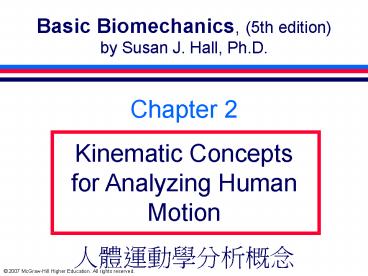Basic Biomechanics, 5th edition by Susan J' Hall, Ph'D' - PowerPoint PPT Presentation
1 / 31
Title:
Basic Biomechanics, 5th edition by Susan J' Hall, Ph'D'
Description:
erect standing position with all body parts facing forward ... anteroposterior axis - around which. rotations in the sagittal plane occur ... – PowerPoint PPT presentation
Number of Views:1140
Avg rating:3.0/5.0
Title: Basic Biomechanics, 5th edition by Susan J' Hall, Ph'D'
1
Basic Biomechanics, (5th edition)by Susan J.
Hall, Ph.D.
Chapter 2 Kinematic Concepts for Analyzing Human
Motion ?????????
2
What is anatomical reference position?
- erect standing position with all body parts
facing forward - considered the starting point for all body
segment movements
3
(No Transcript)
4
Directional terms
- superior closer to the head
- inferior farther away from the head
- anterior toward the front of the body
- posterior toward the back of the body
5
Directional terms
- medial toward the midline of the body
- lateral away form the midline of the body
- proximal closer to the trunk
- distal away from the trunk
6
Directional terms
- superficial toward the surface of the body
- deep inside the body away from the surface
7
(No Transcript)
8
Reference planes
- sagittal plane - in which forward and backward
movements occur - frontal plane - in which lateral movements
occur - transverse plane - in which rotational
movements occur
9
(No Transcript)
10
Reference axes
- mediolateral axis - around which
- rotations in the sagittal plane occur
- anteroposterior axis - around which
- rotations in the sagittal plane occur
- longitudinal axis - around which
- rotational movements occur
11
(No Transcript)
12
Forms of motion
Linear motion motion along a line
- Rectilinear motion (along a straight line)
- Curvilinear motion (along a curved line)
13
Forms of motion
Angular motion rotation around an axis
14
Forms of motion
General motion a combination of linear and
angular motion (includes most human motion)
15
(No Transcript)
16
What is a mechanical system?
- a body or portion of a body that is
- deliberately chosen by the analyst
- examples throwing arm, kicking leg, the trunk
during performance of a lift, the entire body
during performance of a maximal vertical
jump
17
What movements occur in the sagittal plane?
- flexion
- extension
- hyperextension
- dorsiflexion
- plantar flexion
18
What movements occur in the sagittal plane?
19
What movements occur in the frontal plane?
- abduction adduction
- lateral flexion
- elevation depression
- inversion eversion
- radial ulnar deviation
20
What movements occur in the frontal plane?
Abduction
Adduction
21
What movements occur in the transverse plane?
- left right rotation
- medial lateral rotation
- supination pronation
- horizontal abduction adduction
22
What movements occur in the transverse plane?
23
Spatial Reference Systems
- useful for standardizing descriptions
- of human motion
- most commonly used is the Cartesian
- coordinate system
- human body joint centers are labeled
- with numerical x and y coordinates
24
Spatial Reference Systems
Cartesian coordinates of the hip
25
Spatial Reference Systems
Coordinates can be both positive and negative.
26
Qualitative Analysis Prerequisite Knowledge
- What is the purpose of the skill?
- What are the causes of performance errors?
- How can knowledge be gained?
- experience in performing the skill
- reading available literature
- attending conferences and workshops
27
Qualitative Analysis Planning
- What is the question to be answered?
- From what perspective(s) (angle and
viewing distance) should the movement be
viewed? - How many observations should be taken?
28
Qualitative Analysis Planning
- What plans should be made for
- performer attire
- lighting conditions
- background
- use of video
29
Qualitative Analysis Conducting the Analysis
30
(No Transcript)
31
Chapter 2 Kinematic Concepts for Analyzing Human
Motion































